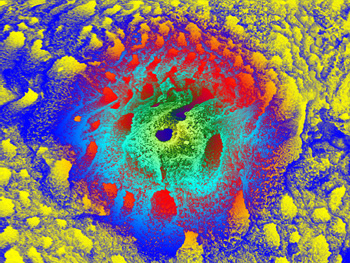One area that “nano” shows up in and is mostly not recognized for is the computer chip industry. The “chip” industry has been working within the nanoscale for years, and is now testing graphene-based transistors that are one atom thick and less than fifty atoms wide (1).
At $200-billion per year (and growing), the chip industry is a major player in terms of employment and revenues, and is a driving force for dozens of other industries and technologies, which is why this is another area that I will cover on a regular basis.
Below you will find a summary of the latest news, covering the period from December 29, 2006, to January 12, 2007.
IBM is testing a new technology that uses “engineered chains of carbon monoxide molecules on a surface of copper.” This technology, while still years away from meaningful products, is one step closer to computing on the scale of individual atoms.
Researchers at Rensselaer Polytechnic are working with hybrid structures consisting of carbon nanotubes and metal nanowires. Resultant technologies could impact many areas within the electronics industry, such as using nanotubes as interconnects in chips.
Foundry United Microelectronics announced plans to open a new 300mm wafer plant in 2008, costing about $5 billion.
DuPont Air Products Nanomaterials is suing Cabot Microelectronics Corp. The issue: “the process used in the manufacture and sale of the slurry polishing compound and pad products needed in chemical mechanical planarization (CMP).”
“A team of researchers from ETH Zurich in Switzerland and Zhejiang University in PR China have demonstrated nanorobotic spot welding using single-crystalline copper-filled CNTs inside a transmission electron microscope (TEM).” (http://www.nanowerk.com/spotlight/spotid=1192.php)
With the end of Moore's Law looming as a possibility, the search for something to replace today's workhorse CMOS-based silicon is intensifying, researchers told the AVS International Symposium & Exhibition in San Francisco last November. (RR: good background information on Moore’s Law and some of the technologies that may extend it) (http://www.eetasia.com/ARTP_8800447621_480200.HTM)
Josh Wolfe (Forbes/Wolfe Nanotech Report) picked IBM’s nanotube electrical circuit research as one of five nanotech breakthroughs of 2006. “The integrated logic circuit consists of 12 transistors made of palladium and aluminum tracing the length of a single carbon nanotube. The circuit is hundreds of times slower than today's silicon processors, but it is 100,000 times faster than any previous carbon nanotube device and has the potential to be much faster.” (http://www.forbes.com/home/personalfinance/2006/12/26/nanotech-breakthroughs-ibm-pf-guru-in_jw_1227soapbox_inl.html)
(1) http://www.rsc.org/chemistryworld/News/2007/February/28020703.asp
Please contact me at rocky at bir-consulting.com for detailed reports on this or any other "nanotech" area, including advanced materials, nanomedicine, energy, cleantech, etc.










